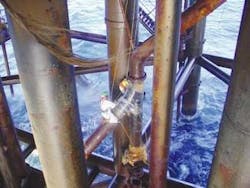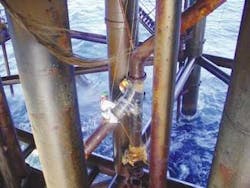Tax brake for UK developers
Jeremy Beckman London
Tax brake for UK developers
Britain Chancellor Gordon Brown refrained from further petroleum tax body blows in his recent budget. After last year's bolt-from-the-blue 10% hike in corporation tax to 40%, he eased off the pedal this time by abolishing petroleum revenue tax on new tariff income. Pre-1993 development projects were subject to 50% PRT on tariffs received from third-party use of pipelines and platforms. Future developments through these facilities will now be exempt.
According to analysts Wood Mackenzie, the government hopes that the benefit of this measure will be felt more widely, in the form of lowered tariffs for new field developments. They point out that tariffs can account for up to two-thirds of operating expenditure in some marginal projects. Wood Mackenzie estimates that as a result of this measure, the value of government take from projects coming onstream over the next four years will decrease by $355 million.
The treasury will hope to claw back this amount through spurring development of previously sub-economic fields: Wood Mackenzie has identified 250 undeveloped finds across the UK shelf. The budget measures could further encourage owners of North Sea gas trunklines such as Miller and Flags to lower their tariffs, thereby easing imports from Norway.
Brown also introduced corporation tax relief changes for R&D expenditure. Deloitte & Touche in Aberdeen points out that for every £1 million spent on qualifying R&D, a large company can now deduct £1.25 million from taxable income, while small equipment manufacturers will be able to deduct £1.5 million, or claim a cash repayment of £240,000.
The unprecedented level of bartering on the UK shelf currently seems to have more to do with global resource realignment by the majors than the benefits of tax tinkering. Among the latest deals, BG has sold $135 million of southern gas basin production interests to French newcomer Perenco; Shell is offering a package of stakes in mature fields inherited through its takeover of Enterprise; and ConocoPhillips has put interests in Audrey, Banff, Gryphon, Maureen, and Miller on the market. Hyperactive independent Venture has acquired ownership of the Kittiwake and Mallard oilfields from Shell and ExxonMobil, in partnership with Dana Petroleum.
Ramco re-visits Celtic sands
Ramco Energy has secured a new license option in the Celtic Sea, off southern Ireland. The acreage, covering parts of blocks 49/11 and 49/12, lies 60 km northeast of Ramco's Seven Heads subsea gas development. This project recently gained approval from the Marine and Natural Resources Department.
The Aberdeen-based operator plans to adopt the same seismic reprocessing technology applied on Seven Heads in 2000, when Ramco acquired rights to re-explore this old discovery. The aim of the technique is to limit seismic multiples provoked by the locally hard chalk seabed. The main geological target will be the same Greensand A sand that has provided most of the gas produced by Marathon's Kinsale Head field 25 km to the south. If positive leads are identified, Ramco has the option to convert to an exploration license.
Development of Seven Heads is well under way. The first well, completed in March, set a new record for the Celtic Sea in the 12 1/4-in. hole section, which was drilled with a single-bit run. Flow exceeded expectations. Castoro Sei has laid and trenched infield pipelines connecting the wells to the Kinsale A platform; CSO Apache is installing infield flowlines and 65 km of control umbilicals.
Ekofisk blueprint unveiled
Ekofisk, Norway's largest producing oilfield, is set for a new expansion phase, designed to extract a further 182 MMboe. The plan submitted by operator ConocoPhillips was due to be ratified last month by Norway's authorities. The central piece of hardware will be a new 30-well wellhead and processing platform (2/4-M) weighing 11,300 metric tons without piles. It will also feature a high-pressure separator, produced water treatment kit, and risers to tie in future local developments.
Kværner Egersund has been awarded the jacket, with Aker Verdal taking on the topsides. The jacket should be set down next year, followed by re-drilling of three wells and installation of the topsides in summer 2005. Ekofisk 2/4-M will be bridge-linked to and controlled from the Ekofisk 2/4-J installation. The overall cost, including 25 development wells, is put at around $1.1 billion.
null
Another big project on the way to completion in 2005 is Statoil's Kristin in the Norwegian Sea. Gas will be piped to the treatment terminal at Kårstø, near Stavanger, though the Åsgard Transport trunkline. As a result, Kårstø's processing capacity is to be increased by over 40% to 88 MMcm/d.
Novel patchwork for Forties
In the UK North Sea, the FDA Alliance (Furmanite/DML) recently repaired a damaged drill cuttings chute on the Forties C platform by employing a carbon fiber composites solution. Internal erosion had caused through-wall damage on the 20-in. line, and its inverted Y shape – and position – below the deck ruled out conventional repair techniques.
FDA's carbon composites solution was applied to strengthen and repair the line. The team calculated that 3.5 mm of composite would suffice to achieve the required 15-year lifespan. The resulting repair consisted of 10 layers of material, 10 mm thick, taking into account potential for future erosion. The chute was then isolated and prepared to a roughness of 75 microns before the abseiling engineers applied the carbon fiber layers, impregnated with epoxy resin. Normal production was maintained throughout the operation.
Exploration stirring
Marathon has a rare oil discovery in the Norwegian North Sea. Its Kneler 25/4-7 well encountered a 155-ft gross column in the Heimdal formation, 7.5 mi west of the Heimdal platform. Two further wells are planned.
Based on a survey of operator intentions, the Norwegian Petroleum Directorate foresees only 15-20 exploratory wells on the Norwegian shelf this year, similar to last year's paltry tally. Expensive dusters in deepwater off mid-Norway caused the sector to lose some of its gloss. The government will hope for a pick-up in the North Sea, however, at least following its latest batch of license awards. Aside from the usual allocations to stalwarts, three independents – RWE-Dea, DNO, and DONG – gained operatorships. Danish state oil company DONG's two new licenses were on the median line with Denmark, close to its operated Siri and Lulita fields.
DONG has also announced that following discussions with the European Commission, new rules should come into force next January opening access to its offshore pipeline network. One aim is to promote competition in Denmark's gas market – currently, DONG is obliged to take all new volumes discovered by the DUC consortium of AP Møller, Shell, and ChevronTexaco. DONG itself has aspirations to be a force in European gas exports and marketing. It recently clinched the sale of 150 MMcm/year to Sweden through Goteborg Energi.

